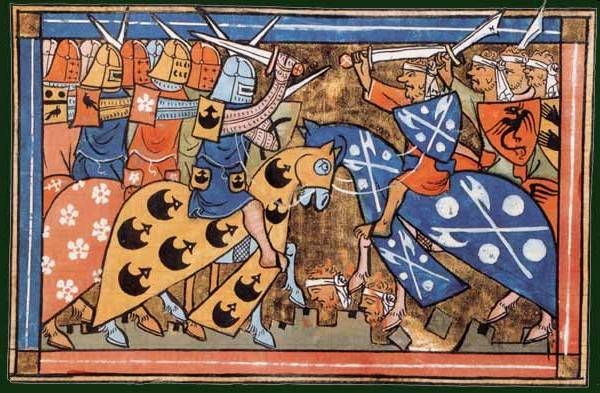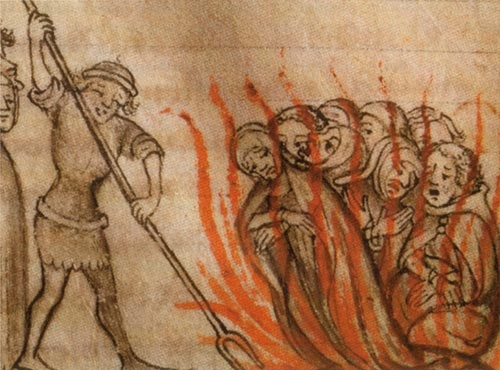After Jerusalem fell to the crusaders in 1099, most of the crusaders who did not return to their homelands became dedicated to establishing independent Christian states. There arose two problems for the remaining crusaders: how to protect the pilgrim routes to the newly won holy places - and the defense against Moslems surrounding the narrow strip of reconquered lands.
At this time there were only about five hundred knights available to maintain the kingdom of Jerusalem, therefore small groups banded together to take on these tasks. One such band was formed in 1115 by Hugh de Payens of Burgundy and Godfrey de Saint Adhemar, a Fleming, who recruited seven other knights from northern France. This small voluntary group escorted pilgrims from Jerusalem to Jericho and on to Jordan, the traditional site of Jesus' baptism. In 1118 the group swore an oath to protect the pilgrims and observe the monastic vows of poverty, obedience and chastity.
The two founder-members had originally only one horse between them, a situation reflected in the order's seal. Under their vows they were to wear only clothes which were given to them and to own no possessions other than their weapons. From these inglorious beginnings came their first name - the Poor Knights of Christ. Impressed by their devotion, the king gave them quarters in a wing of the royal palace which was located on the supposed site of the Temple of Solomon. This soon gave rise to a new name for the group - the Knights of the Temple, or Knights Templar.
The number of knights had grown by that time and they felt that they should be officially endorsed along monastic lines in accordance with their vows but with allowances for their military role. Around 1124 Hugue de Payens approached the Council of the Catholic Church, meeting at Troyes in France. It was this council which gave the Knights Templar the statutes which established them as an official military-religious order.
The Order's hierarchy consisted of the Grand Master, Seneschal, Deputy Master, Marshal, and the commanders or Masters of the provinces. Each province was divided into houses known as preceptories, each with its own commander, or preceptor. These divisions were used both in the field and in the administration of monastic life.
The seal of approval from both the Pope and Bernard of Clairvaux, abbot of the Cistercian monastery of Clairvaux, and from the beginning a strong supporter of the Templars, resulted in generous donations for the order. Preceptories were quickly formed not only in Jerusalem, but in Antioch, Tripoli, Aragon and Portugal. In time preceptories were founded in Hungary, Germany, Sicily, and Greece. By spring of 1129 Templars had established a strong foothold in France, England and Scotland. In Scotland, around Aberdeen alone, a substantial quantity of Templar property was held including houses and churches in Turiff, Tullich, Maryculter, Aboyne, and Kingcausie. South of Aberdeen at Culter, they possessed a huge estate of no less than 8,000 acres.
By the second half of the 12th century the Order was flourishing and had become one of the leading landowners in Syria and Palestine. Funds and recruits continued to arrive from Europe and in order to manage this great wealth the Templars became experts in banking. By as early as 1148 they were moneylenders, despite the Church ban on usury and they soon had one of the most efficient banking networks in the western world. Pilgrims could now not only rely upon the protection of the Templars but could deposit money at their local preceptory and withdraw it as required by producing a letter of credit at any other preceptory.
With a common Rule, the Order's legal and economic status was similar in almost every country, however it was only in the great capitols - London, Rome and Paris - that financial dealings took precedence. Outside the capitols, each commander or preceptor used his allotted lands in the appropriate way - farming, spinning, brewing and baking.
The Order's military reputation and strength was also growing swiftly. Throughout the 12th century the Templars, together with the Hospitaller knights, were the finest fighting force in the Holy Lands. In time however, partly because fewer recruits could be found who were willing to die for the faith and partly due to growing rivalry between the various military orders which had now been created, the Templars' military strength in the Holy Land began to decline.
When Acre fell to the Moslems in 1291, after a siege of the castle which lasted weeks and included fire bombs, catapults and mines, the Holy Land was lost forever. Over 20,000 Templar knights and sergeants had met their deaths since the Order's inception. The Templars had lands in Cyprus and it was here that they created a new headquarters in the Middle East.
Other than a few unsuccessful raids on the Syrian and Egyptian coasts, the Order deteriorated into one of bankers and moneylenders. A series of verbal attacks was launched against all military orders, the Templars in particular, suggesting they no longer had a purpose for existence since they failed to take steps to regain the Holy Land. Nothing came of these attacks until a renegade Templar, Esquiu de Floyrian, made specific charges of blasphemy, idolatry and sodomy against the Order to Phillip the Fair (Phillip IV) of France.
The Pope was informed of the charges in 1305, and at the end of the following year the Grand Master, Jacques de Molay, was summoned to Rome. Apparently unaware of the charges against the Order, de Molay rejected the Pope's proposal that the Templars and Hospitallers unite to form one order and that a new crusade be launched. After de Molay returned to Cyprus in 1307 Phillip once again pressed the charges. The Pope agreed to an inquiry.
On September 15 of that year Phillip sent sealed instructions for the seizure of all members of the Order and their property throughout France. The brothers were thrown into prison where all except three eventually confessed – under torture – to the charges. Powerless in the light of the confessions, the Pope issued a command to all Christian princes to arrest Templars in their lands.
Soon, under torture, Templars were confessing to homosexuality, devil worship, blasphemy and corruption. In England, Spain, Cyprus and Germany they were found innocent of the charges; but in France the persecution continued and many Templars who retracted their confessions when the torture ended were burned at the stake as heretics. Finally, in 1312 the Order was suppressed; its vast wealth passed on to the Knights Hospitaller.

The Crusades were a series of religious wars sanctioned by the Latin Church in the medieval period. The most commonly known Crusades were the campaigns in the Eastern Mediterranean aimed at recovering the Holy Land from Muslim rule ... Read more at Wikipedia.

Several significant changes in legal procedures had been made by 1230 that affected later trials, especially those of the Templars. No longer did a witness need fear reprisals if his accusations were proved untrue. Read more at Wikipedia